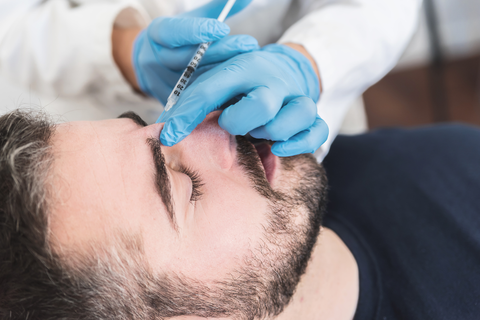Injectables 101: Botox vs Fillers
Key Differences Between Botox and FillerAs a practicing procedural dermatologist, I have hundreds of conversations about the merits, limitations and risks associated with neuromodulators (aka Botox, Dysport, Daxxify, Xeomin) and fillers (aka Juvederm, Restylane, RHA) on a monthly basis. In this blog, I will explain what Botox is, what filler is, what they can do for you and equally important what they can't do for you - that way you are an educated consumer should you ever decide to try them or at least have a better understanding of what other people are doing.
What is the Difference Between Botox and Filler?
Simply put, Botox or neuromodulators in general, are used to relax muscles that cause wrinkles while dermal fillers are used to restore volume. If you look in the mirror and raise your eyebrows, squint your eyes or furrow that area between above your nose, you will see lines form from the underlying muscles. These are dynamic lines and Botox relaxes those muscles to make those creases soften.
Filler, on the other hand, is used to add volume back to an area. It does not relax muscles. As we age, we lose muscle and bone mass making our skin in our face gravitate downwards. This can lead to hollowness around the eyes, loss of well-defined cheekbones, and folds that extend from the side of the nose to the corners of the mouth (nasolabial folds). Filler is one tool to address these changes.

What is Botox?
Botox is one option in a category of drugs called neuromodulators. They are derived from a bacteria called clostridium botulinum, which is the same bacteria that can cause botulism or lockjaw. Botox works by blocking how a nerve and muscle communicate. Through a complex process, your brain fires a nerve that tells a muscle to contract. Botox blocks the final step in the process, preventing the signal from the nerve to activate the muscle. The more you inject, the stronger the effect.
What Are Alternatives to Botox?There are a number of neuromodulators on the market. The most famous is Botox, but there is also Dysport, Xeomen, Jeauveau and Daxxify. These are made by different companies, and they are all FDA approved. Interestingly, Botox was first brought to market and FDA approved for strabismus, when eyes point in different directions, and ophthalmologists were using it to relax muscles to help bring the eyes into alignment and found it softened the wrinkles of skin at the same time.
What Does Botox Do To Your Face?Botox is used in countless ways, but let’s focus on its most common uses:
Forehead: Weakens the frontalis muscle to soften the horizontal lines people get on their forehead when they raise their eyebrows.

Glabella: Used between the eyebrows to soften the ‘eleven’ lines or ‘frown lines’ seen by contraction of the corrugator muscles.

Crows Feet: This softens the creases that form on the outside of your eyes when you are squinting.

Does Botox Hurt?
Very small needles are used to inject Botox, a 30 gauge needle or smaller. This can be uncomfortable, but typically well tolerated and very brief. Some areas of the face are more sensitive than others (the lips are the most sensitive.) Also, each zone that you get treated will require more than one injection. The forehead requires 5-10 injections. The glabella might require 3-5 injections, and the crows feet area is often 3 injections on each side. Learn more about What It's Like Getting Botox.
How Long Does Botox Last?
No matter if you love or hate your Botox, it will always wear off which is why Botox is a great first step into the world of cosmetics.
Most injectors of Botox charge by the unit. A smaller number of injectors charge by the area that they are injecting (ex. crows feet could be $200 per side regardless of the number of units). The cost per unit can be anywhere from $10-25 depending on zip code and credentials of the injector.
A very rough average of Botox units used per area is as follows:
- Forehead: 12 units,
- Glabella: 20 units
- Crows Feet: 12 units on each side.
Some people with strong muscles need more while smaller muscles need less. Also units vary between product being used. Daxxify requires more units than Botox, and Dysport more still.
First Time Getting BotoxYou first need to find an injector. Ask your friends where they have had good experiences (and bad ones to avoid). Look online, at reviews, but also at photos of the providers. Is their look an aesthetic you like? Are they too done? Then have an in-person consultation. Do not plan on having the treatment the same day unless you really connect with the provider and make sure before they treat you, you are confident that if something goes wrong, they can fix it. If you decide to proceed, take it slow. Learn more about why Less Is More When You First Start Botox.
When Should I Start Botox?When YOU want to, when you are more excited to try it than scared. You can start at 25 or 65. There is no hard and fast rule.
Can You Stop Doing Botox After You Start?Yes. You can stop Botox at any time with no downsides other than lines will slowly come back. .
What Are The Long Term Effects of Botox?There appears to be no negative health effects of long term Botox. It has been used in large amounts for hundreds of diagnoses for decades. However, some find over time you either need more Botox to get the same effect or that your body seems to process it faster. Others find as they age and the muscles get smaller, they can use less botox. Talk with your provider about changes you are experiencing so we can tailor the treatments or even change to a different neuromodulator as things change.
What Do Dermal Fillers Do?Fillers restore volume aka ‘fill up space’. They don’t cause muscles to relax. They don’t make the creases and lines in our face go away that form when we squint, raise our eyebrows or scowl. Instead, they provide volume to enhance the appearance of cheekbones, jaw structure, lip fullness and other parts of the face.
What Types of Fillers Are There?Fillers are generally made of hyaluronic acid (ex. Juvederm, RHA, Belotero, Teoxane, Restylane). There are also biostimulatory fillers like Sculptra and hydroxyapatite (Radiesse)
How Long Does Filler Last?This can vary from 6 months to 2 years depending on the product. In general, the thinner the product the shorter time it lasts. For example, people generally want a soft and less firm (thinner) filler in their lips. These fillers last on the shorter side of the spectrum. Alternatively, in cheekbones and jawlines where we want more structure, the products are firmer and tend to last longer.
Does Filler Hurt?The process of getting filler can be uncomfortable. Larger needles are used to inject filler than what is used for Botox because the filler is thicker than Botox. Areas that get filler can be sore for a few days, particularly if there is bruising. Sculptra, on the other hand, usually results in a few days of achiness because your body develops a lot of inflammation to it, which is actually what we want to happen to stimulate new collagen.
Can You Feel Filler?Usually you can feel filler if you really try to find it. When you get filler in your lips, you can typically feel it a little bit between your fingertips. Same with the nasolabial folds. However, you wouldn’t feel it throughout the day if you weren’t touching it and it becomes less noticeable even to the touch over weeks as it settles into your skin.
What Are The Risks of Filler?The risks of filler vary in severity. Standard risks that go with any injection include pain, bruising and bleeding. Allergic reactions and infection, although rare, can happen. Asymmetry is also a possibility, meaning that one side of your face looks different than the other. You can get inflammatory nodules from filler and that can show up right away or months later. If filler is accidentally injected into a blood vessel, it can also block that blood vessel and the tissue supplied by that vessel can get permanently injured. Strokes, blindness and loss of tissue are all reported complications of filler use. Be sure to discuss this with your injector so you understand these risks and that your provider is able to reverse filler should you need that to happen.
Where Can Filler Be Injected?Filler has been used all over the body. The most common place to get filler in the face is cheekbones, lateral face, under the eyes, in the lips and nasolabial folds. Less common places include the bridge of the nose (‘liquid rhinoplasty’), temple regions, along the jawline and in the chin. Some people also get filler in their hands to help camouflage tendons and blood vessels as they age.
Should I Get Filler or Botox?This question really comes down to your priorities and budget. A syringe of filler can cost anywhere from $500-1200, and most syringes have 1cc of material. That is only 1/5th of a teaspoon. So it often takes 2 to 3 syringes to get noticeable change depending on your facial anatomy, goals, and where you want it injected.
What is Sculptra?It is a biostimulator solution that has to be mixed before your appointment. We then inject it and your body builds collagen on top of that leading to global volumizing and natural results. But, because your body has to do the work, you are not going to see those results for three months.
What If I Don’t Like The Filler Results?Hyaluronic acid fillers have the ability to be reversed, unlike Radiesse and Sculptra. There is an enzyme called Hyaluronidase that can be injected into an area to dissolve away hyaluronic acid. The process is imperfect, however, and might require a few visits and injections. Further, there is some naturally occurring hyaluronic acid in your body that it will also dissolve.
These recommendations are not sponsored. They are the result of Dr. Heather D. Rogers, MD evidence-based research and extensive clinical experience.
To learn more, sign-up HERE to receive weekly educational newsletters from our founder and dermatologist, Dr. Heather D. Rogers, MD.
The information on doctorrogers.com and our social media channels, including articles, newsletters, videos, blogs and related links, are provided for general information and educational purposes only. There is no doctor-patient relationship implied and it is not a substitute for obtaining medical advice from your physician. Use of this information and recommended products on this site is at your own risk. Further, their use indicates your agreement with the Terms and Conditions of doctorrogers.com. There is no intent to diagnose or treat any specific medical problem through any of the information shared. Additionally, information shared here is not an extension of the medical care Dr. Rogers provides at her practice.

